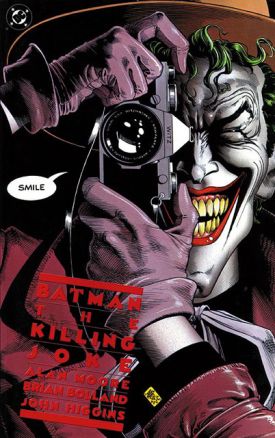Comics /
Back Issues
Batman: The Killing Joke
By Frederick Haddox
February 3, 2008 - 20:37
Upon hearing about the recent death of Heath Ledger, I pondered about the Joker and his role in our society. Ledger’s joker, who seems insane for the sake of being insane, somewhat differed from the one first conceived by Jerry Robinson. Batman: The Killing Joke quickly came to mind as a story that seemed to offer key insight into the origin of the Joker, the rationale for his actions and his relationship with Batman.
The story begins with the Batman visiting Arkham Asylum. His intention is to discuss with the Joker their problems and find a reasonable solution. Here we see Batman in rare form as he tries to negotiate a peaceful settlement. After receiving an unintelligible answer, Batman quickly learns that he’s been talking to a Joker impersonator.
The story then takes us to the actual Joker, who is preparing a plot against Commissioner Gordon and ultimately Batman. Amidst this preparation, we witness a parallel story about the Joker’s beginnings as a chemist who quits his profession and pursues his fantasy of being a stand-up comic. The pressures of having to perform on stage compounded with the upcoming arrival of his first child, has brought about feelings of inadequacy. He tries to remedy this by accepting an offer to guide these criminals to a playing card factory, via the chemistry lab where he used to work. There, he insists on wearing the old Red Mask costume which neatly ties this story with the original Joker story first featured in Batman #1. This part of the story follows the familiar motions of red masked-man entering the chemical factory, confronting police and falling into a chemical vat to escape Batman.
The present day story illustrates Joker executing his plan with accuracy, a sense of style and impeccable wit. Breaking into Commissioner Gordon’s home, the Joker shoots Barbara Gordon while incapacitating the Commissioner. After taking some revealing photos of Barbara, the Commissioner is carried of to an abandoned amusement park where the Joker is hiding out. Batman goes to the hospital, hears Barbara’s description of the more sinister Joker and heads for the Joker’s liar. Unpredictably, Batman frees Commissioner Gordon and confronts the Joker. After the normal physical pleasantries, an enlightening conversation begins. Batman shows empathy and for a moment he and the Joker can be seen as equals, void of any polarity of good or bad. Batman’s offer to counsel the Joker is met only with a joke. The story concludes with a share of laughter at each other’s expense.
Moore’s treatment of the Batman and Joker is still refreshing, even by today’s standards. Boland’s artwork is superb. Little is overdone in Boland’s rendering of these classical characters. There’s only a slight embellishment that meshes well with the overall sensation of the story. Higgins’ coloring is creative in the fact that the overall colors “change up” every two or three pages allowing the reader to be refreshed and not bored. I highly recommend this work. It’s essential reading if you want to learn more about the Joker.
Last Updated: January 17, 2025 - 08:20
